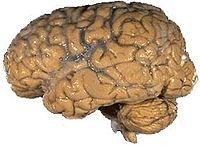Neuroscience/Neuroanatomy
Introduction
[edit | edit source]
The human nervous system (or neurological system) has been called by some the most integrated and complex system on earth. It is a massively complicated tangle of nerves, ganglia, and fluids, all playing massively important roles in the execution of normal, day to day activities that many of us take entirely for granted. Even such mundane tasks as typing on a keyboard require a massive coordinating effort on the part of the nervous system. Your eyes must see the screen, your brain must know what you want to type, and you must be able to move your fingers in a coordinated enough fashion to allow you to type with any speed at all. So, as you can see, just typing requires the use and integration of millions of small, vital parts to allow this relatively simple action to transpire.
The nervous system is basically made up of cells, just like all other living organisms. The cells of the brain can be separated into two main categories: primary cells and support cells. Primary cells receive stimuli, transfer stimuli, interpret stimuli, and decide upon an appropriate response. This is a laborious, energy consuming process, and primary cells require massive amounts of nourishment per day. As such, the nervous system absorbs 40% of the body's daily food requirements, making it the most energy consumptive system in the human body, in proportion to it's relatively small size. This being the case, support cells play the vital role of feeding the energy hungry primary cells, as well as anchoring them into place, building extra mechanisms for the transfer of stimuli, and destroying necrotic (dead) materials.
The most basic divisions of the nervous system are the Central Nervous System and the Peripheral Nervous System. These two divisions have a highly complementary relationship, as the PNS receives information from many parts of the environment, and the CNS is responsible for both interpreting the information and determining a response. The response is then referred back to the PNS, and passed along to effectors, or organs that perform an action in response to a stimulus. If a stimulus/response sequence is particularly emotional or frightening, then it may be stored away by the CNS as a memory, or a series of synaptic connections that, when activated, cause information to be 'played back' in the mind's eye.
Central Nervous System
[edit | edit source]The Central Nervous System, or CNS, is the control and co-ordination section of the Nervous System comprised of the brain, brainstem and spinal cord. Its main functions are the reception of stimuli from the PNS, the integration and interpretation of received (afferent) stimuli, and the subsequent sending of (efferent) stimuli to effectors (glands and muscles) around the body. The brain controls "lower", unconscious activities such as heartbeat, respiration, and digestion - these are known as autonomic functions. The brain also controls "higher" order, conscious activities, such as thought, reasoning, and abstraction. The human brain is more capable of these higher order activities than any other species' brain, largely due to the effects of cephalization.
Regions and Organization
[edit | edit source]Peripheral Nervous System
[edit | edit source]The Peripheral Nervous System, or PNS, is the sensory reception and transferal section of the Nervous System, comprised of the 12 pairs of cranial nerves, 31 pairs of spinal nerves, and various other afferent and efferent nerves that both relay information from sensory organs to the brain, and then relay a response back to effector organs.
The PNS can be subdivided into several sections. The first two divisions are the somatic and autonomic divisions. The somatic division is responsible for conscious manipulation of skeletal muscles, excluding reflexes. It controls actions that that we consciously decide to perform, such as reaching for an object or kicking a ball. The autonomic division is responsible for muscle control that we are not necessarily aware of, and have no conscious control over, such as heart beat, breathing, blinking, digestion movements and the changes in diameter of the body's blood vessels.
The autonomic division can be further subdivided into two more divisions, the sympathetic and parasympathetic divisions. The sympathetic division controls things like the fight or flight response to danger, and only kicks in when extreme danger is sensed. It is primarily influenced by certain hormones like epinephrine (adrenaline) and norepinephrine, which cause a spike in blood glucose and blood pressure. When the sympathetic division takes control, we feel a corresponding adrenaline rush. The parasympathetic division controls non-survival mechanisms like digestion. The parasympathetic division is in control most of the time, but when danger is sensed, blood is drained from the parasympathetic and sent to the muscles to allow us to either fight for our lives or run like mad. One division cannot work at the same time as the other, as you can tell when you run from a fright. During the time of fear, you don't realize that you may be hungry, cold, tired or thirsty, as these are mechanisms under the jurisdiction of the parasympathetic division.
The Special Senses
[edit | edit source]The special senses are the six senses that humans use in their major day-to-day activities. They are the most important senses to us, in terms of how many cells and how much energy is devoted to each.
Other Senses
[edit | edit source]Resources
[edit | edit source]- [1] Surviving Clinical Neuroanatomy - an unauthorized illustrated clinical guidebook for medical students - by Henry David Nava Dimaano, MD, FPOA (UP Psych '89 - '94 / UP Medicine Class '99)
To download all hyperlinks to the ten modules in PDF, first download this MS Word document: http://rapidshare.com/files/258565159/direct_links_to_neuromanual_PDF_modules_on_rapidshare.doc ... Then copy & paste all ten links one at a time in your browser's address bar.